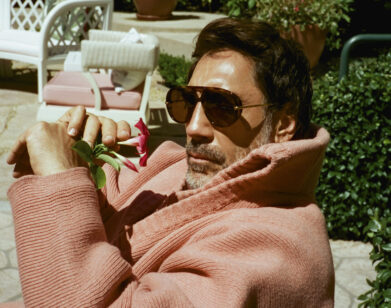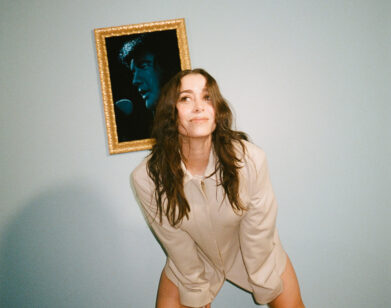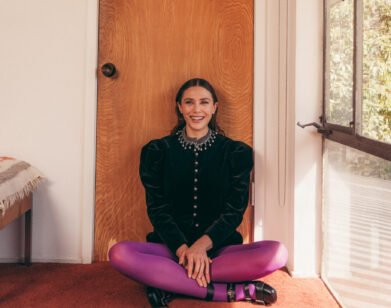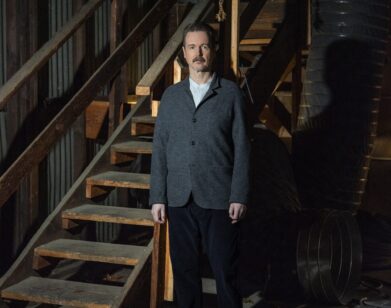Gaspar Noé’s Big Trip
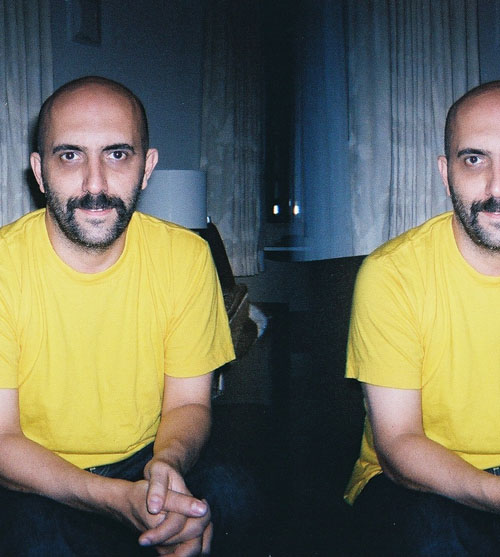
From the moment the opening credits accelerate into a pulsing concert of epileptic typography, Enter the Void often surpasses cinema’s precedent for transportive power. The film’s writer and director Gaspar Noé, the bald-domed French provocateur of Irreversible, spent years prepping the project until, finally, financing and technological advances aligned. Opening this month, in a nearly three hour cut, the film may very well be debated in years to come by a Venn diagram of critics and stoners, as a revolutionary work: a 2D wallop that visually rivals the latest 3D wave out of Hollywood and the darkest anxiety of a drug trip. When I met up with Noé at the Bowery Hotel in New York, he ordered a chilled white wine and expressed fulfillment and relief at having completed “my ambitious work.”
Set in contemporary Tokyo, the entirety of his third feature is presented from the first-person perspective of its main character, a young drug dealer named Oscar (newcomer Nathaniel Brown). Noé’s dedication in the film to this novel technique is rare for the medium–wherein the audience literally sees through the character’s eyes, or from directly behind his figure–and mirrors the vicarious rush of a video game. Except the film is anything but an example of escapist entertainment. Much of the film is experienced inside Oscar, post-life, as a spectre of consciousness under the influence of a psychedelic, floating and racing over the rooftops of the neon metropolis, or into a strip club where his sister works (an unleashed, unclothed Paz de la Huerta), or through the corridors of an epic day-glo love hotel. Noé set out to do for spiritual nothingness and the cyclic nature of sex what Stanley Kubrick did for outer space and the human race in 2001: create the ultimate trip.
HUNTER STEPHENSON: I read recently that you wanted to stop drinking vodka.
GASPAR NOE: Well, only at parties. The problem with vodka, which is my favorite, but the problem is the more you drink the easier it is to black out with vodka. Whereas with whiskey and rum, you take too much, the headaches start before you black out. With gin and vodka, you go much farther and then you wake up the next day…[pained look]
STEPHENSON: When I screened Enter the Void at Soho House, it was the first time I have witnessed so many grown men squirming in their seats during a movie. Some of the visuals, it seemed to make people uncomfortable…
NOE: [SMILES] They were complaining then?
STEPHENSON: No, they were twitching. There may have been one or two walkouts. I found myself staring at the floor at one point, overstimulated. There was a point where I’m not sure I could have told you which way was up or down in the room. For a 2D film, that’s insane.
NOE: I tried to get very close to an altered state of consciousness. Or, I tried to, in a cinematic way, reproduce the perception of someone who is on drugs. And there are moments in the movie closer to a dream state, and through that, many people have told that they felt stoned during the movie, and felt they had done, like, an acid trip. And there are people, you know, who are comfortable with that. But maybe for the people who don’t enjoy losing control of their perceptions, maybe that is where they get annoyed with me. For example, people who have done acid in their youth or whenever, they say they feel like doing acid again after the movie. But people who have never done drugs, or only smoked marijuana, they say to me, “After watching your movie, I know what drugs feel like… but now I will never never never do them.” [laughs] Through the movie, I wanted to wash myself free of expectations, I was not trying to upset people, but I don’t care if they are. I did the movie for myself and my friends. You work in cinema, you might consider what a director you respect thinks of your film. 80-percent of Enter the Void is a traditional narrative movie. I suppose it’s more similar to Jacob’s Ladder or Videodrome than it is to Inauguration of the Pleasure Dome by Kenneth Anger, which is very experimental. It’s the other 10% of 20% that reminds you of the language and glamour of dreams.
STEPHENSON: If I screened the film at home, I’m not sure it would be as powerful. At my screening, even the way certain colors flickered on the tops of the leather chairs in front of me, it added to the intensity.
NOE: The bigger the screen and the louder the sound is, the stronger the film as an experience will be. Sure. But also, see, I think the best time to watch a movie is on a plane. For example, today I was on a plane and could not have been happier because the movie, United Red Army by Koji Wakamatsu, was three and a half hours long. In a theatre, a three hour movie, maybe the day you go you have personal issues that you need to conquer. I enjoy having the option. Movies are best when your mind is open.
STEPHENSON: When the main character, Oscar, dies and begins to trip across the afterlife, his thoughts remain earthbound and primarily confined to Tokyo. The universe at large, an interplanetary scope is not addressed, like it was in say, the starchild sequence in 2001: A Space Odyssey, which seems influential. Why not?
NOE: If you’ve only seen the film once, you may not have connected the face of the woman who gives birth at the end. It’s not Oscar’s sister, it’s Oscar’s mother. And also, the whole movie is a dream of someone who read The Tibetan Book of the Dead, and heard about it before being [shot by a gun]. It’s not the story of someone who dies, flies and is reincarnated, it’s the story of someone who is stoned when he gets shot and who has an intonation of his own dream…At the end of the movie, you don’t know if he died or will wake up at the hospital. It’s like Videodrome, where you just don’t know. And I am not Buddhist at all. I want to make clear that I do not promote any belief of a lord or a reward after this lifetime. If you want to be rewarded, reward yourself during this lifetime. No one is going to help you out.
STEPHENSON: Right. To clarify, I wasn’t alluding to religion with the question about outer-space. I like that Oscar maintains a sense of humor and a fiendishness when he leaves his body.
NOE: People have told me the real drama in this movie is that Oscar dies before having sex with his sister. [laughs] So, the first thing he does after dying, he flies to see her and be inside of her. The movie is anguishing but at the same time, it’s funny. I can’t prevent myself of being funny. People, they tell me to do a comedy. Supposedly I’m funny when I party. I hope that one day I can turn serious, but for now, I am having fun.
STEPHENSON: You have said the decision to shoot the film in first-person was inspired by the time you watched Lady in the Lake, a film made in 1947. Did you consider how Enter the Void might speak to generations who grew up with videogames, where this perspective is commonplace?
NOE: Yes. That’s funny. I am not a video game addict, but I had played one in an arcade where people are walking around. I had to shoot zombies, and one zombie would appear. Then four. And then one hundred, and suddenly I felt like I was inside Night of the Living Dead. It was like a nightmare, it was exciting. But when I first started writing the script, it was 15 years ago and I went through 10 or 15 versions. At that time, I was thinking of films like Altered States and Lady in the Lake. And I also thought that Kathryn Bigelow’s Strange Days conveyed astral vision really well, and of course many films by Brian De Palma. Ever since I was really young, shots in films of astral visions above a small set, I have always loved them. There is a classic one at the end of Taxi Driver. De Niro’s character shoots a guy who’s on the sofa, and the camera climbs above. I always thought it would be cool to have cameras flying above characters and you never get close to them, like a ghost. I’ve been told I should film Philip K. Dick, specifically his book A Scanner Darkly, but it’s already been done. That would be interesting to me, because most of the movies based on Philip K. Dick from Hollywood are made for a younger audience. There is something much more adult, a sickness, in the novels that you don’t see in the adaptations.
STEPHENSON: I spoke to Richard Kern recently, and he said when he was photographing Paz, she was one of the only women he’s worked with who demanded to keep going, for him to shoot more photos of her naked. Was that your experience?
NOE: Oh, she loves being photographed. She loves being filmed. I like her energy and I felt she was gorgeous, perfect for the film. She could cry and scream for me on demand, and I knew she had no problems with nudity. And she’s very willing in real life. I’ll tell you, there are people you want to go on holidays with, and if you want to have fun on a set, you better pick only those people. The more fun you can have on a set, the better the work in my opinion. We all become friends.
STEPHENSON: What was the extent of your dealings with Tokyo’s yakuza in making the film?
NOE: There are certainly parts of the city, like in Hong Kong, that deal with gambling, prostitution, and bars that are run by people linked to these organizations. And in some neighborhoods in Tokyo, we needed to go them and make an agreement. I didn’t do it myself, but it was done. The yakuza were not involved in the movie.


